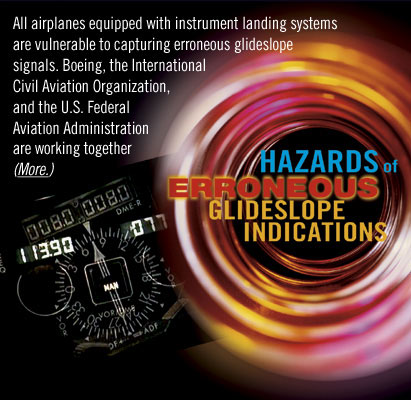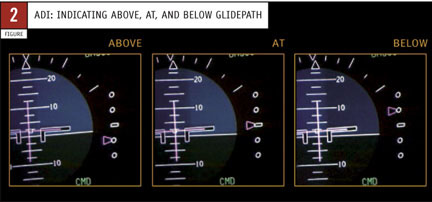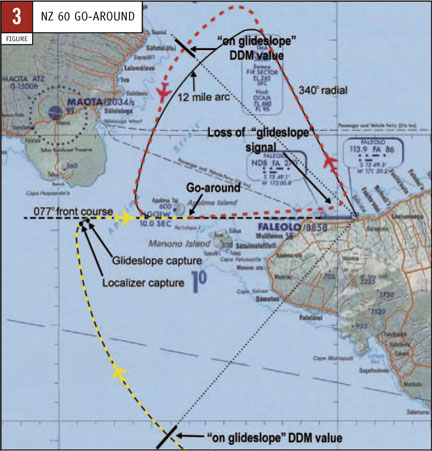Published: January 2003

All airplanes equipped with instrument landing systems are vulnerable to capturing erroneous glideslope signals. Boeing, the International Civil Aviation Organisation, and the U.S. Federal Aviation Administration are working together to improve awareness and prevent such errors. Flight crews can help manage the risk by understanding the problem and performing glideslope confidence checks.
With the advent of instrument landing systems (ILS) in the 1940s came the possibility of erroneous or false glideslope indications under certain circumstances. One such erroneous indication recently occurred on several 767, 777, and Airbus airplanes, resulting in coupled ILS approaches being flown toward a point short of the runway. This kind of problem can occur on any airplane with any ILS receiver.
Boeing has taken action to help prevent such incidents by revising operations manuals and working with the International Civil Aviation Organisation (ICAO) and the U.S. Federal Aviation Administration (FAA) to address maintenance errors that can cause erroneous glideslope signals. The subtle nature of the indications makes it imperative that flight crews also help manage the risk by understanding the problem and performing glideslope confidence checks.
This article describes
- Incident involving an erroneous glideslope signal.
- Causes of erroneous glideslope signals.
- Flight crew actions.
- Industry actions.
1. INCIDENT INVOLVING AN ERRONEOUS GLIDESLOPE SIGNAL
On the night of July 29, 2000, an Air New Zealand 767 was on a routine flight from Auckland, New Zealand, to Apia, Western Samoa. The night was moonless, with scattered clouds that prevented visibility of the runway lights.
The flight crew members were experienced in conducting routine automatic landing approaches in low visibility. They considered a routine automatic landing approach to be safe if the autopilot was coupled to the airplane, no warning indications were visible, and a valid Morse code identifier signal came from the ground navigation aids.
Well prepared before descent, the flight crew thoroughly briefed for the approach. When the crew selected the approach mode, the glideslope capture occurred almost immediately. All ILS indications appeared to be correct. With all three autopilots engaged, the captain concentrated on configuring the airplane and slowing it for landing. The crew attributed the slightly steep descent of the airplane to its heavy weight and tailwinds. The crew noted a good Morse code identifier signal and no warning indications. At 1,000 ft, the crew completed the landing checks. Shortly thereafter, the first officer observed the close proximity of the island lights out his side window. The captain noticed that the distance measuring equipment (DME) indications differed slightly from what he would have expected.
The captain executed a timely go-around 5.5 mi from the runway at an altitude of less than 400 ft. The crew successfully executed a second approach by using the localiser and ignoring the on-glideslope indications.
2. CAUSES OF ERRONEOUS GLIDESLOPE SIGNALS
Investigation of the Air New Zealand incident revealed important information about the causes of erroneous glideslope signals. Understanding these causes requires a discussion of the ILS an d its normal operation.
ILS ground equipment provides horizontal and vertical guidance information to airplane instrumentation. The equipment typically comprises five components: a localiser transmission system, a glideslope transmission system, a DME or marker system, a standby transmitter, and a remote control and indicator system (fig. 1).

During normal ILS operation, the localiser and glideslope transmitters each radiate a carrier wave of 90- and 150-Hz signals of equal amplitude. These signals alone do not provide guidance but are compared with separate 90- and 150-Hz side-lobe signals radiated by the localiser and glideslope to create complex interference patterns. The patterns are designed so that when an airplane is below the desired glideslope, the instruments will sense a predominance of 150-Hz signals; when the airplane is above the desired glideslope, the instruments will sense a predominance of 90-Hz signals; and when the airplane is on the glideslope, the instruments will sense equal amounts of 90- and 150-Hz signals (fig. 2).

The ILS was designed to protect against transmitter malfunctions. If a primary transmitter malfunctions, the system automatically will transfer to the standby transmitter. If the ILS does not change over to the standby transmitter, or if the standby transmitter is faulty, the system automatically will shut down, and an alarm will sound in the control tower.
It is important to note that, because the Morse code identifier signal is carried only on the localiser carrier signal, the flight crew only knows whether or not the localiser is transmitting. No information on the health of the glideslope, localiser, or other functions is provided.
On the night of July 29, 2000, the glideslope side-lobe amplifier was not operating in Apia. In addition, the ILS ground equipment had been left in bypass mode following calibration maintenance. This prevented system transfer to the standby transmitter. No alarm sounded in the control tower because the cable that fed information to the tower navigation status displays had been cut during construction. As a result, the Air New Zealand flight received only the glideslope carrier wave transmission, which was interpreted by the instruments as being on glideslope, with no warning indications.
3. FLIGHT CREW ACTIONS
The Air New Zealand incident exemplifies why flight crews need to be aware of the potential for erroneous glideslope signals, even when the ILS is indicating correctly and a distance-altitude check is performed at glideslope capture. Frequent crosschecks and crew vigilance are key in detecting potential problems.
Crosschecks.
A single distance-altitude check does not guarantee the subsequent descent path will be correct. Similarly, a single altitude check crossing the outer marker does not guarantee the glideslope is correct. The best strategy is to crosscheck the airplane altitude against distance periodically during descent. Methods to accomplish this include
- Crosschecking altitude and DME distance periodically.
- Crosschecking altitude and flight management system (FMS) threshold distance.
- Crosschecking altitude and the crossing altitude of the outer marker (or locator, very-high-frequency omni-range [VOR] navigation equipment, or FMS).
- Crosschecking radio altitude and barometric altitude.
- Crosschecking ground speed and rate of descent.
- Questioning air traffic controllers when indications do not appear to be correct.
Similar erroneous indications can occur with the localiser signal. Crosschecking the signal with other navigation indicators, such as VOR and navigation database course heading and tracking information, can help reduce risks in such occurrences.
Crew vigilance.
Human factors were very important in the successful outcome of the Air New Zealand incident. Crew-members were alert to possible ILS problems because notice to airmen (NOTAM) bulletins had informed them that the ILS was unmonitored, and they discussed this during their approach briefings. They also paid attention to subtle cues that something might be wrong, even though the automatic flight system was indicating normally. Last, the crew-members were willing to execute a go-around to give them more time to sort through the conflicting information (fig. 3).

4. INDUSTRY ACTIONS
Boeing, the FAA, ICAO, and others in the aviation industry are working together to address the problem of erroneous glideslope indications. Actions have included issuing maintenance guidance, improving equipment, revising flight crew training manuals and operations manuals, and facilitating discussions at industry safety forums.
Maintenance guidance.
ICAO and the FAA have released guidance for the proper conduct of ILS ground maintenance activities. The guidance
- Clarifies the content of NOTAMs that are sent when maintenance work is in progress and the possibility of false indications prohibits the use of a particular approach aid.
- Recommends that maintenance personnel confirm whether or not a NOTAM has been issued before beginning ILS maintenance testing.
- Recommends that the Morse code identification feature be suspended when maintenance testing is in progress.
- Recommends that air traffic control advise the flight crew, either by voice or through an automated terminal information service (ATIS), that ILS maintenance testing is in progress and that the flight crew should not use the glideslope or localiser.
- Recommends that maintenance personnel turn off the glideslope transmitter during localiser testing and turn off the localiser transmitter during glideslope testing.
Equipment improvements.
In the case of the Air New Zealand flight, the ground proximity warning system (GPWS) did not warn the crew flying the erroneous glideslope. This is because the airplane did not have an excessive closure rate with terrain and the flaps were in landing configuration. However, an airplane equipped with a terrain awareness warning system (TAWS) (e.g., the Honeywell enhanced GPWS) would have warned the crew of the situation because TAWS compares the flight path with a terrain database. TAWS is standard equipment on all in-production Boeing airplanes and is available for retrofit on all models delivered before 2000.
Training.
In addition to improving equipment, Boeing has revised its flight crew training manuals and operations manuals and has sent all airline customers a 26-min CD-ROM video, "New Zealand 60 — A Free Lesson." The video and revised manuals detail the problem of and solutions to erroneous glideslope indications.
Safety forums.
Boeing also promotes discussion of erroneous glideslope indications in various industry safety forums worldwide.
SummaryThe transmission of erroneous ILS information at Apia on July 29, 2000, was caused by an unusual set of circumstances. However, technicians will continue to conduct testing and maintenance of airfield navigation aids. A similar situation could occur in any ILS-equipped airplane during what appears to be a routine instrument approach. The best defences against erroneous glideslope indications are understanding how the ILS works, equipping airplanes with modern warning systems, and implementing training and procedures that ensure crew-members are prepared to take appropriate action. Flight crew action should include crosschecking the airplane altitude against distance periodically during descent. Special recognition is given to investigators David Stobie, Rod Smith, Chris Kriechbaum, Bob Henderson, Joey Anca, and Dr. Gordon Vette for their contributions to understanding this incident. |
Editor's note: Additional copies of the training video, "New Zealand 60 — A Free Lesson," may be obtained from the Flight Safety Foundation, 601 Madison St., Suite 300, Alexandria, VA 22314; telephone 703-739-6700; fax 703-739-6708; web site http://www.flightsafety.org/.
DAVID CARBAUGH
CHIEF PILOT
FLIGHT OPERATIONS SAFETY
BOEING COMMERCIAL AIRPLANES
CAPT. BRYAN WYNESS
VICE PRESIDENT
FLIGHT OPERATIONS
AIR NEW ZEALAND
| Top of page | Boeing Home | Boeing Commercial | Contact Aero |
Aero Copyright © The Boeing Company. All rights reserved.